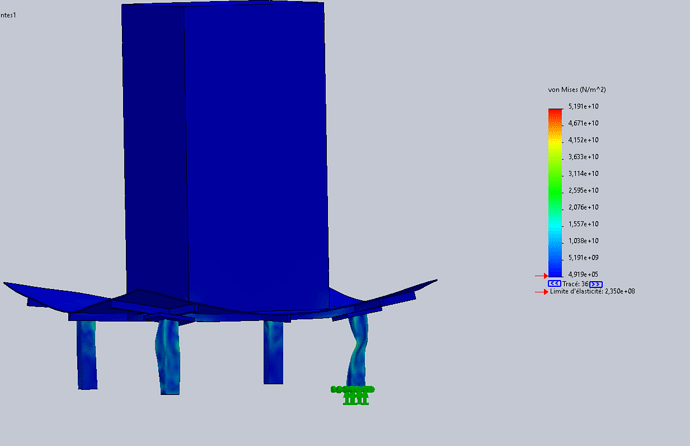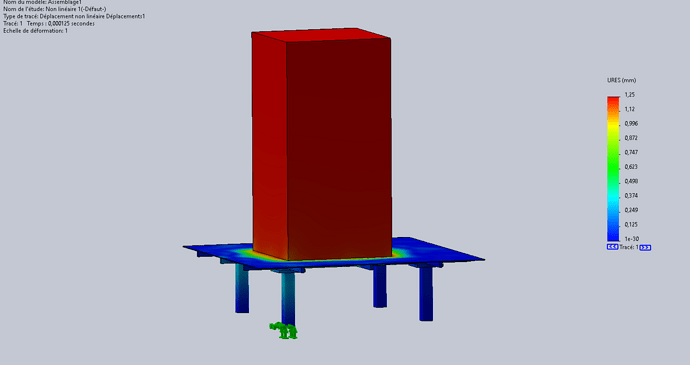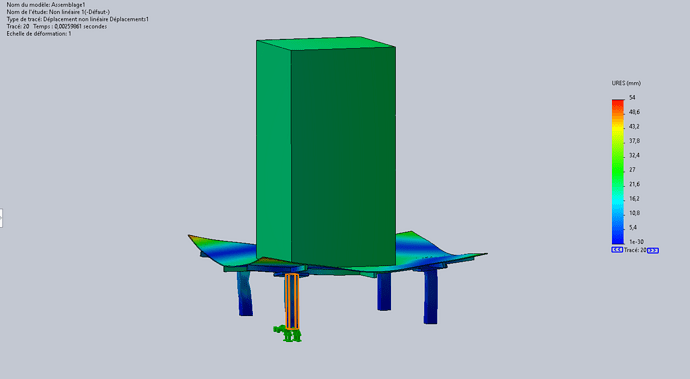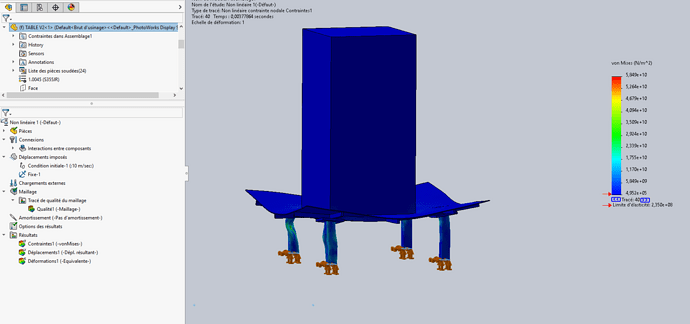Information given by the customer: 2 cubic meters of material with a mass vol. of 550Kg/cubic meters. No particular shape... It's light but that's all I have.
The results can vary depending on the shape, of course, but I think you can start with a square contact surface of 500X500.
Hello
Your request is delicate, do you have the appearance (in approximate section) of the projectile to be dampened by the table already built?
otherwise in detail it's a hassle ...
The following parameters:
***Coefficient de restitution*** : Le coefficient de restitution mesure la capacité d'une surface à rebondir après un impact. Il est défini comme le rapport de la vitesse relative après l'impact à la vitesse relative avant l'impact. Un coefficient de restitution proche de 1 indique un rebond élastique, tandis qu'un coefficient de restitution inférieur à 1 indique un amortissement.
*Déformation de la structure* : Lors d'un impact, la déformation de la structure peut indiquer l'amortissement de l'énergie cinétique. Une déformation importante de la structure peut absorber une partie de l'énergie cinétique de l'impact.
*Temps de contact* : La durée du contact entre les surfaces en collision peut également influencer l'amortissement. Un temps de contact plus long permet une dissipation d'énergie plus importante, ce qui peut contribuer à l'amortissement.
*Matériaux utilisés* : Les propriétés des matériaux utilisés dans la structure peuvent également jouer un rôle dans l'amortissement. Certains matériaux, tels que les matériaux viscoélastiques, peuvent avoir des propriétés d'amortissement intrinsèques.
OK, I'll modify the projectile and we'll see the results...
I think above all that I was given a good PDP from the families, and that we are not equipped to solve this kind of case...
In any case, thank you for your help 
For me it is better to put a point that hits the sheet metal if a block of ferritic stone a stone is never square and sooner or later it is a peak of the stone that will hit the table in 1st (and center it because the most critical point in my opinion)
Yes, you can start with a pyramidal shape, the object will never have a flat surface...
otherwise a vision with 10m/s at impact on the table and second after 20 iterations.
For the 1/300 respect it is difficult to guarantee, I restart the study with a pointed form.
Is your simu made with the same method as the twathle video?
So his method is quite long... I have set up as my capture in nonlinear study with a very low iteration step to have the deformation on your table.
In Pack and Go 700 MB of data with simulation.
At the 40th iteration I am at 3/1000 s after the impact on the table.
the deformation is restored at 1/1
Hello!
In the initial conditions, why not put 9.81 directly in acceleration?
it avoids the calculations of before
Hello
@twathle,
The acceleration is of course 9.81 m/s² in the entire free-fall phase of the table. But at the beginning of the shock phase, it is the speed of impact that defines the energy to be dissipated to stop its movement. It is this speed value that is the initial condition of the shock, the acceleration of gravity no longer has any role to play, except to consider the weight of the block.
@clement.Merlin,
In one of your messages, you indicate a density of 550 kg/m3 and a volume of 2 m3 for the ore block. A quick search on the internet gives a density 10 times higher for this material (between 4600 and 5200 kg/m3).
So a volume of 0.2 m3 for a mass of 1100 kg (i.e. a cube of nearly 0.6 m on each side).
I am interested in simulating contact in static first, then in dynamics, on a principle similar to that of the video proposed by @twathle. Even if these simulations are open to criticism in some of their aspects, they clearly show that the table will not survive the first shock.
More detailed comments in the attached document...
Kind regards.
Chute.pdf (528.4 KB)
Hello m.blt,
I share your speed of 14m/s see my message, it is clearly better to work on the connection of the feet. Thank you for the work you have done and the explanations given.
Kind regards.
Spectrum.
Hello
I took back as they were the values my client gave me. Being himself "in the field" and I am not, I rely on his expertise as to his assessment of the densities concerned...
For the simulation itself, we suspected within the board that it would not pass. The key was to demonstrate with relative certainty the overreach and dangerousness of the thing.
Thank you 
having a colleague who performed a scan on site, confirms that the volume concerned is 2 m3. This has an even greater impact if we refer to the values you offer.
I'll talk to the client about it.
Thank you very much
To give a more precise context;
A vertical conduit (at least 10 m high) leads to a hopper at the bottom, which in turn leads to a screen (large sieve).
During the sieve repair operations, there was a risk that residues stuck to the walls of the duct would fall on the workers. The idea that must have emerged on the spot was "we make a table that will take the stone in our place, above our head, and give us time to leave". Of course, only transportable set, assembleable and dismantled by hand (max 30kg per piece), Model manufactured, and requested for verification after the fact (of course).
That changes everything in my opinion. A pile of agglomerated dust will already burst on impact, which will greatly reduce or distribute the impact (compared to a hard and compact block)
In addition, I imagine that the 2m3 is just to count wide and equally distributed on the 10m of duct.
So not 2m3 that falls 10m but much less and then more or less evenly distributed.
It's like taking the contents of a bucket of sand (even a very tightly packed one) on your head or taking the same bucket of sand + hardening cement nothing to do with a similar density.
I couldn't agree more, but in this case not knowing which model to start with I thought that the most unfavorable case was to be expected




